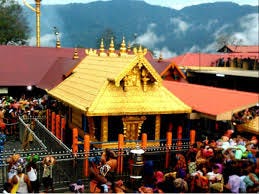Sabarimala season begins; there is a Buddhist connection too, to Tibet
This is an ancient site of spiritual power going back millennia
The Sabarimala pilgrim season begins tomorrow (16th November) this year.
Sabarimala is a site of spiritual power that has been continually worshipped for millennia. Deep in the forests of Kerala, it has been a center of worship by Hindus and Buddhists apparently for a very long time.
Interestingly, there are deep connections with Tibet’s Buddhists too. The deity was worshipped simultaneous as Siva by Hindus and the Avalokiteswara Padmapani by Buddhists.
It has been the single biggest religious gathering in the world in terms of pilgrim numbers, and in concentrated groups, it is only open for the period mid-November to end-December.
But more recently, it has been the site of severe tensions, as the ‘secular’ government of Kerala has both siphoned off pilgrim donations while doing nothing to provide facilities (which are downright pathetic); and, armed with with court orders tainted by contempt of traditional practices, attempted to desacralize it.
The idea was to graft western ideas of “womens’ rights” on to the women devotees who have traditionally, for arguably scientific reasons to do with their fertility, not visited the temple in their child-bearing years.
A shocked counter-campaign by women devotees has temporarily spared the temple.
It has become some sort of a totem for the fraught ‘secular’ politics of India, where the Hindu majority finds itself under continuous and withering attacks.
Sabarimala has also become a touchstone for whether the rising Hindu awareness of how the Indian State and Constitution discriminates against it can be resolved amicably.
Here’s a very old (1997) column of mine about the startling ancient history of the shrine.
https://www.rediff.com/news/dec/31rajeev.htm
Excerpt:
The Buddhist Connection: Sabarimala and the Tibetans
It is a winter phenomenon, starting in mid-November, at the beginning of the Malayalam month of Vrschikam (Scorpio), and lasting until mid-January. All over South India, you find pilgrims in the distinctive attire of the Ayyappan sect -- dressed all in black or blue, hirsute; singing songs in praise of the Lord of Sabarimala. They set out, after forty-one days of penance, on a long journey to the River Pamba and then a rugged trek to the sanctum.
The appeal of Sabarimala, a remote and tiny temple in a valley in the Western Ghats of Kerala, has increased phenomenally in the last couple of decades; it is now believed to be the world's second largest annual pilgrimage in terms of the number of devotees, second only to the Haj in Mecca. It is a most unusual pilgrimage to a most unusual deity; for Sri Ayyappan is Hariharaputra, the Son of Lord Vishnu and Lord Siva -- and this is the only ancient temple to Him.
It is likely that the unusual myth of the Son of Vishnu and Siva is due to another historical event: a reconciliation between Saivite and Vaishnavite Hindus. Unlike other parts of the South, where the two were often in conflict, Kerala has typically seen harmony between them.
I have been on the Sabarimala pilgrimage several times, and it is a remarkable experience: one is swept away by the palpable tide of faith all around one. The climb up from the Pamba riverbank to the sanctum is difficult: up steep slopes, through dense forests. Since you walk uphill barefoot, with a small sack on your head (a two part sack, representing one's deeds, both sins and good deeds), it is not easy: but the pilgrims chant that the sharp pebbles underfoot are as mere flowers.
… end of Excerpt







